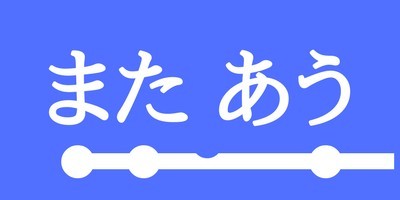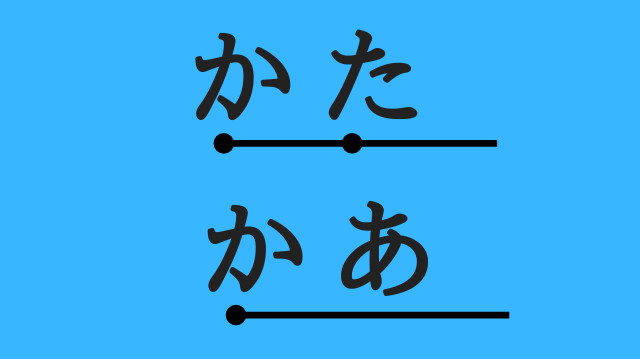As you learned in the beginning of this course, the Japanese language only has five vowels. But if that’s true, then what the heck are “long vowels” in Japanese?
Well, since there are such a small number of different vowels in the language, it is pretty common for one vowel sound to be immediately followed by the same vowel sound which makes the entire thing sound like one long sound.
That being said, there are times when a “double vowel” doesn’t quite sound like a single sound. Let’s learn about them now!
What Is A Long Vowel?
If we take a look at the sound that か makes we can notate it as [ka] and see that the consonant is the [k] and the vowel is the [a].
What can happen in certain words is that this か is followed immediately by an あ which also has the [a] sound to it. This then creates an overall sound like [kaa].
It is the exact same sound, so rather than changing any movements in the mouth we simply hold onto it again.
If you think of each morae as a “beat” in music, then we could say that you hold the [a] vowel for two beats in situations where the vowel is long, such as in かあ.
This concept of “beats” is actually one that I found to be helpful when learning how to correctly pronounce Japanese words. Each of these hiragana characters is given the same amount of “air time” when you pronounce them.
If you take a look at the featured picture for this post at the top, then you will see that I put two examples with lines and dots underneath them.
The first one かた is two morae, which means that each one gets a single beat. Since there are two consonants and two vowels in this combination, it very clearly sounds like two sounds [ka-ta].
The second example is also two morae, but since there is only one consonant and the two vowels are the same one it sounds more like there is only a single sound [kaa]. The trick is that this word still gets two beats.
This is another example of why thinking of Japanese sounds in mora instead of syllables in helpful.
- The word かた has two syllables and has two morae
- The word かあ is one syllable, but has two morae
Try saying both of the words yourself. Can you see and hear the difference between morae and syllables?
They Are Not All The Same
The concept of long vowels is simple enough. You simply hold the same vowel sound in the word for twice as long and you normally would. However, there are a few things that you will need to be aware of.
The first thing you should know is that, generally speaking, the elongated vowels will sound like one continuous sound. If I sound like I’m repeating myself, bear with me. It will soon become apparent why I keep mentioning this.
Take a look at this picture as it shows how most elongated vowels will sound.

Having said this, there will occasionally be words that have the structure of a long vowel, but the vowel sound actually reiterates itself halfway through.
It’s not all that common, so you don’t need to worry too much about it. I would also add that it’s rare for people to adhere to it when they are speaking quickly or slurring their words, but it does occur often enough to warrant mentioning it here.
Usually this happens when the ending vowel of one complete word is the same as the beginning vowel of the following complete word.
When you run into a situation like this, it looks a little something like the picture below.

The first word また means “again” and the second word あう means “to meet” so this is a common way to say “see you again” in Japanese.
You can see that it’s easy to just hold onto the [a] vowel at the end of また and let it be the beginning [a] in あう which would look like [mataau] if we wrote it in English.
But as you can see from the picture, it is common to have just the tiniest of dips at the end of the [a] vowel in the た so that it can go back up to full force at the beginning of the あ which helps separate it into two separate words.
If I had to write it I would do something like [mata’au] since there’s not a clean break between the two [a] vowels in each word, but it’s not a total fusion either.
This is also little bit different from when we completely switch to a different vowel such as the あう [a-u] part in the second word which I’ve illustrated with the white circles.
It can be helpful to know that this sometimes happens so that when you hear elongated vowels you can ask yourself, “is this one continuous sound, or is there a small reiteration of the vowel?”
Again, the rule of thumb is that if a new word begins, then there is usually a reestablishing of the same vowel.
Try Not To Stress The Long Syllable
The next thing I want to talk about with these long vowels is that, as English native speakers we tend to have an unconscious disposition towards putting stress on one of the syllables in each word that we speak.
The reason is because that’s how English works. We always have one syllable that receives extra emphasis.
In Japanese, all syllables receive equal stress. I’ll go into much more detail about this on the pitch accent lesson coming up soon.
The reason why I bring it up now is because the long vowels feel like the right place to put the stress when you come from an English background, so I wanted to let you know to be careful and give any long vowels the same amount of force (not more) than all other syllables in the word.
The Written Language Can be Deceiving
Something else that I would like to share with you has to do with the written part of Japanese. The thing is, all five vowels can be long depending on the word, but they way that these long vowels are actually written can be a little tricky when it comes to two of them.
In particular, I’m talking about the elongated え [e] and お [o] sounds.
Generally speaking, when the え sound is elongated it will be written with the hiragana い for the second mora, but it should still have that [e] sound to it.
So even though えい looks like it should be read as [e-i] it is actually read as [ee].
Likewise, when the お sound is elongated in written form, it will usually be written with the う kana for that second beat.
So even though おう looks like it should be [o-u] it is actually read as [oo].
To make matters even worse, there are a few exceptions to the above rules!
Meaning that sometimes you’ll see え and お written for the second mora, or sometimes the い and う actually are the [i] and [u] sounds respectively.
But generally speaking, the “rules” that I explained first are what you should use.
The Japanese language is actually pretty dang good at having its written system match its phonetics when compared to other languages (like English!).
What you have to keep in mind is that the written part of the language has been changed many times over the years and that it is supposed to be a reflection of the spoken language.
The spoken language came first, so it gets the final say when there is a disagreement between the two.
Cool Words To Try Out
I’ve thrown in a couple of words that do not have elongated vowels in them, so that you can compare and contrast them to the ones that do have elongated vowels.
Pay particularly close attention to these word pairs and notice the difference in both their pronunciation and meaning.
おばさん = Aunt
おばあさん = Grandmother
–
おじさん = Uncle
おじいさん = Grandfather
–
しゅじん = Husband
しゅうじん = Prisoner
–
おいしい = Delicious
めいわく = Trouble
These Words Lead To Jokes
As you can see from the list above, the meaning of a word can completely change if you hold on to the vowel for just one beat more.
This can create jokes in shows and anime where a character calls a middle-aged woman おばあさん by accident giving the impression that she looks like she is in her 60s instead of her 30s!
Or how about the closeness of the Japanese words for “husband” and “prisoner”? If you hold on to the う sound just a little too much, you might give people the wrong impression when you introduce your spouse at parties!
Once you’re done with that, it’s time to move on to the opposite of long vowels: Stop sounds!
Leave your questions and comments below!
Go to the Table of Contents
Go to the next lesson
Further Resources for Learning Japanese:
#3 Get My eBook (Secrets to Learning Japanese) for Free

またね!

so what are the exceptions? I’m trying to Google for the exceptions and this is the first result.
Are you asking about the words that are spelled with two おお kana instead of the more common おう formation for an elongated [o]?
I don’t have a list of them, some common words that immediately come to mind are とおい “far”, おおかみ “wolf”, and こおり “ice”.
A few expectations eh? I’m guessing exceptions!
Crap, I messed that one up! Good catch, thanks!